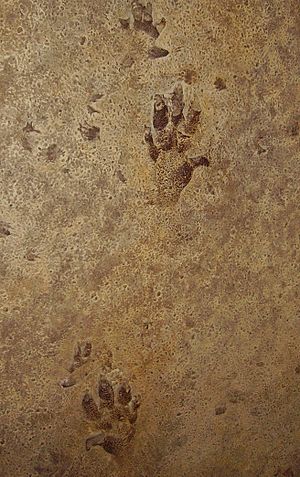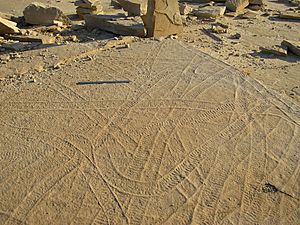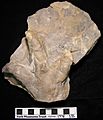Trace fossil facts for kids

Trace fossils are special kinds of fossils. They are not the actual remains of ancient living things, like bones or shells. Instead, they are signs of what those creatures did when they were alive. Think of them as clues left behind by animals and plants from millions of years ago!
These clues can be many things. They might be footprints, like those left by dinosaurs. They could also be burrows, which are tunnels dug by animals in the ground or under the sea. Other examples include feeding marks, where an animal chewed on something, or even fossilized droppings, called coprolites.
Trace fossils are different from body fossils. Body fossils are the actual parts of an organism, like a bone or a tooth, that have turned into rock over time. Trace fossils, however, show us the behavior of an ancient creature, not its body.
Contents
What Are Trace Fossils?
Trace fossils are like a diary of ancient life. They show us how organisms moved, ate, or lived. For example, a fossilized footprint tells us an animal walked there. A burrow tells us an animal dug a home. These clues help scientists understand how ancient creatures lived their daily lives.
Sometimes, tiny living things like bacteria can also leave traces. For instance, stromatolites are layered rock structures made by ancient bacteria. They are also considered trace fossils because they show the activity of these tiny organisms.
Studying Trace Fossils
The study of trace fossils is called ichnology. Scientists who study ichnology are called ichnologists. They look at the shapes and patterns of these traces to figure out what kind of behavior made them.
It's important to know that trace fossils are named based on how they look and what kind of behavior they show. This is different from how we name animals or plants. For example, many different types of dinosaurs might have made similar footprints. So, the footprint itself gets a special name, even if we don't know exactly which dinosaur made it. This helps scientists talk about and classify these ancient clues.
Different Kinds of Trace Fossils
Trace fossils come in many forms, each telling a different story:
- Footprints and Trackways: These are marks left by feet or bodies moving across soft ground. Dinosaur footprints are famous examples. They can tell us about an animal's size, how it walked, and even if it traveled in groups.
- Burrows and Borings: These are tunnels or holes made by animals. Burrows are usually in soft sediment, like mud or sand. Borings are holes drilled into harder materials, like wood or shells. They show us where animals lived or hid.
- Feeding Marks: These are signs left by animals as they ate. They might be bite marks on bones or scratch marks on rocks where an animal scraped for food.
- Coprolites: These are fossilized animal droppings. They can tell scientists what an ancient animal ate, which helps us understand ancient food chains.
- Root Cavities: These are spaces left by plant roots that grew in ancient soils. They show us where plants once grew.
Gallery
-
Thalassinoides, burrows produced by crustaceans, from the Middle Jurassic, southern Israel
-
Trypanites borings in the Ordovician from Kentucky. The borings are filled with diagenetic dolomite (yellowish). The boring on the far right cuts through a shell in the matrix.
Images for kids
-
This coprolite shows distinct top and bottom jaw bite marks, possibly from a prehistoric gar fish. Discovery location: South Carolina, US; age: Miocene; dimensions: 144.6mm X 63.41mm or 5.7” X 2.5”; weight: 558g (1lbs 4oz)
-
Cast of a tridactyl footprint of theropod dinosaur "Eubrontes" from the Triassic of the Czech Republic
-
Cross-section of mammoth footprints at The Mammoth Site, Hot Springs, South Dakota
-
Petroxestes borings in a hardground from the Upper Ordovician of southern Ohio
-
Asteriacites (sea star trace fossil) from the Devonian of northeastern Ohio. It appears at first to be an external mold of the body, but the sediment piled between the rays shows that it is a burrow.
-
Numerous borings in a Cretaceous cobble, Faringdon, England; see Wilson (1986)
-
Entobia from the Prairie Bluff Chalk Formation (Upper Cretaceous). Preserved as a cast of the excavations.
-
Helminthopsis ichnosp., a trace fossil from the Logan Formation (Lower Carboniferous) of Wooster, Ohio
-
Lockeia from the Dakota Formation (Upper Cretaceous)
-
Lockeia from the Chagrin Shale (Upper Devonian) of northeastern Ohio. This is an example of the trace fossil ethological group Fugichnia.
-
Inverted trace fossil of an unidentified tridactyl ornithopod
See also
 In Spanish: Icnofósil para niños
In Spanish: Icnofósil para niños


























